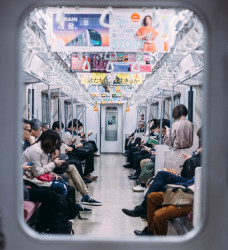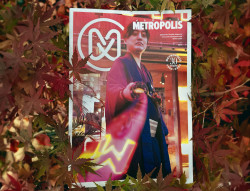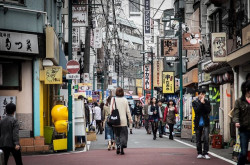
January 4, 2013
Sorry For Being A Genius
An exclusive interview with controversial artist Makoto Aida
By Metropolis
Originally published on metropolis.co.jp on January 2013


For most of his career, Makoto Aida has been the enfant terrible of the Japanese art world. But now this exciting and iconoclastic artist is being welcomed in out of the cold by the art establishment with his first major retrospective at the Mori Art Museum.
Entitled “Monument for Nothing” (the Japanese title translates as “Sorry for being a genius”), the show brings together art from the 47-year-old artist’s entire career, including most of his major works.
To mark the occasion, Aida not only granted Metropolis an exclusive interview, but also agreed to provide some design elements for our cover and layout in what must be some of his less shocking pieces of art.
While most contemporary artists seek to provoke but fail, over his twenty-year career Aida has been able to push people’s buttons almost without trying. A good example was his effortless response to 9/11. This was a poster drawn in a pseudo-naïve style, reminiscent of John Lennon’s paintings that showed the view from the cockpit of one of the planes that crashed into the World Trade Center, with the word “Imagine” emblazoned under it. Cruel, cynical and snarky, but definitely a work of casual brilliance.
With Aida’s art, there are degrees of shock—possibly fifty shades, as there are obvious affinities with the sado-masochism of that best-selling novel. As testament to this, the exhibition has a curtained-off, adults-only room, a bit like the porno section of a DVD-rental shop. Cross that threshold to encounter some of Aida’s more extreme and sexually explicit artworks, like The Giant Member Fuji versus King Gidora (1993), an anime-style tentacle-rape scene, and his infamous Dog series (1996). This features naked, underage-looking girls, painted in a delicate and beautiful nihonga style, leashed like dogs with their limbs reduced to bleeding bandaged stumps—yet looking serenely happy.
Pictures like this may suggest the worst kind of sexual deviant or manic otaku, so it is with some trepidation that Metropolis sits down to interview the artist against a backdrop of cardboard figures made by volunteer art students as part of the exhibition.

Surprisingly, Aida is not wearing dark glasses and a facemask, nor is his handshake cold and clammy. Instead, he presents a pleasant if disheveled appearance and a down-to-earth, genial personality with none of the pretentiousness associated with the professional artist. We start off by inquiring about the sexually explicit content of much of his art.
“Well, it’s not just me,” he replies matter-of-factly. “In modern, developed countries, because of the amount of sex surrounding us, people have become something like monkeys in a zoo, masturbating on and off. Whatever is in my paintings is, in a way, entirely natural, because people have made such things.”
But reflecting society is not a random process. Aida adds that, when working on a piece, he is often motivated by “that moment when I show it to people… I’m working towards that day when I can reveal it. Various thoughts come to my mind,” he reveals. “One would be that I want them to chuckle or be shocked.”
Yet if it seems the artist takes nothing but joy in his process of creation, Aida says another motivation is the desire to get an artwork out of the way. “[It] can also be like ‘I don’t want to do this anymore. I want to stop doing this. It’s a pain, a drag.’ But the drive is I’m going to show this to someone one day,” he clarifies. “The audience is important. I couldn’t do it if I was on a desert island.”
One work that may have been a drag, simply because of the time and effort required to paint it, is Ash Color Mountains (2009-11), an expansive canvas showing a vast heap of meticulously painted human figures. It was originally inspired by the economic downturn and the corporate downsizing this led to—the painting shows office workers literally thrown onto a scrap heap. But the Great East Japan Earthquake’s occurrence when Aida was working on it gives the painting a resonance of this disaster.
This, and other of Aida’s paintings, reflect various critical perspectives on society. It seems his art is not merely about what will impact on his audience, but is also driven by the opinions and beliefs of the artist. One unmistakable strand is a strong anti-American feeling. For example, A Picture of an Air Raid on New York City (1996), displays Japanese planes bombing and strafing that city’s skyscrapers in what seems a partial precursor of 9-11. “The peak of my anti-US emotions came when I was 12,” Aida comments. “I lived in New York in 2000, so I’m telling you I know the United States. Am I anti-US now? Probably not…
Anti-Americanism can also be found in the sexually explicit and scatological manga Mutant Hanako (1998) and its tale of American abuse during the occupation period.

“That terrible comic strip shows Japanese anti-US feelings in an exaggerated format…” explains the artist. “It’s so exaggerated that it’s a gag.” But he expands on the sentiment as one against “foreign countries, not just the US, but China—the superpowers! I feel some need to be on our guard. It’s also large amounts of capital, huge corporate entities, and things like that.”

Such backtracking seems in harmony with one of the exhibition’s aims, which is to clarify Aida’s reputation while also softening it to make his essentially shocking art more palatable to a wider audience. If so, the main challenge will be to play down the underage erotic elements in his art, or at least alter the way they are viewed. This is not particularly easy as some of his most eye-catching recent works, like Picture of Waterfall (2007-10) and Monument for Nothing (2012), show once again his artistic obsession with schoolgirls.
What attracts him to these subjects? Aida talks about a purely aesthetic attraction that derives from their ambiguity and doll-like appearance.
“Before you’re 12, you’re a child. If you’re older than 14 you’re an adult. You’re in this ‘Which am I?’ kind of situation. You don’t exist in either group. That kind of timing is something that can’t be explained in words,” he explains. “Girls at that time of life—their appearances and their movements—do have something mystical I think, but when they talk I’m always turned off very much, so I don’t really want to talk to them, I don’t want to look at their interior.”
On another level, Aida’s artistic obsession with pubescent girls is related to the central experience of his life—coming to Tokyo from rural Niigata. In this explanation, the girls act like a kind of indicator of moral and spiritual health. The innocence and purity seen in Picture of Waterfall can be contrasted with the depravity and self-destructiveness of the urban subjects in Harakiri School Girls (2002).
“I come from a rural area and I came into Tokyo later in my life,” he explains. “Maybe I have this beautified longing for my hometown,” he explains. “I wanted to come to Tokyo, but there’s something sick about Tokyo. So Harakiri School Girls is Tokyo’s sick situation amplified, but this Waterfall is the beautiful hometown where I was born nearly 50 years ago amplified. It’s so beautified that it’s unreal.”
While it’s easy in these paradoxically puritanical yet perverse times to dismiss Aida as a misogynistic and morally suspect individual, it is less easy to dismiss the power of his art. This exhibition will enable people to appreciate it more deeply. Despite being in some senses a very ordinary person, Aida could be seen as a genius. But why should he apologize for that?
His artworks impact viewers with their strong and direct visual ideas, but there is also a lot more to Aida’s art than meets the eye. Does he ever regret employing shocking and erotic elements in his art, and the fact that this has come to dominate how he is perceived?
“I have no regrets,” he immediately replies. “When I was younger, I read the novels of the Marquis de Sade. You know those very dark pieces that you have to enjoy by yourself, secretly making sure people don’t see you enjoying them? I aspired to create work that is enjoyed in that style. I think I have achieved that.”
“Aida Makoto: Monument for Nothing.” Mori Art Museum, until Mar 31, 2013







